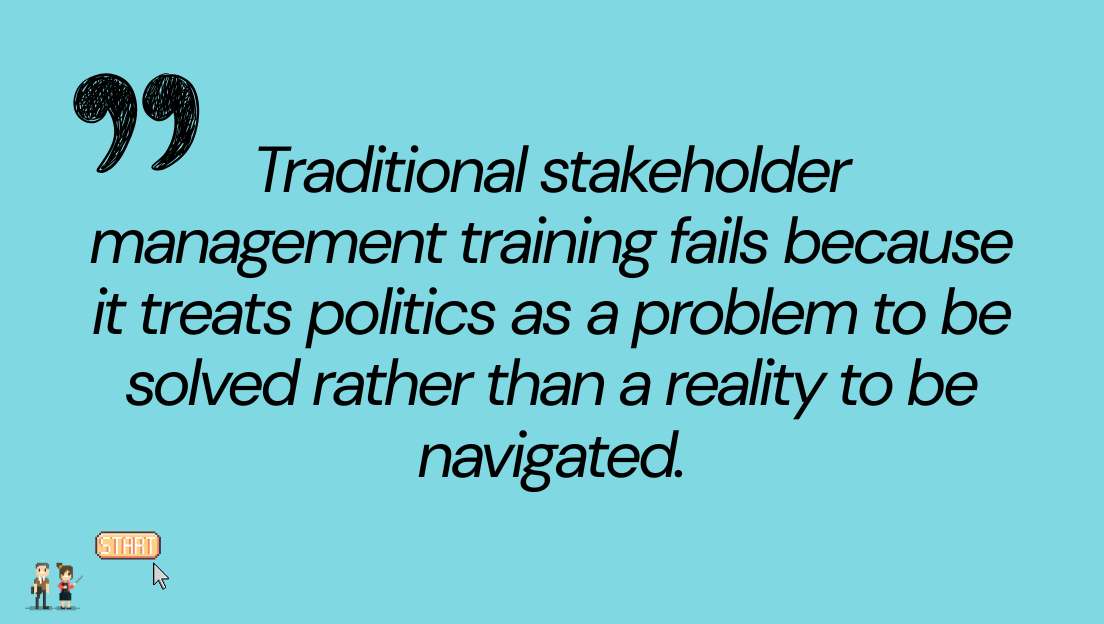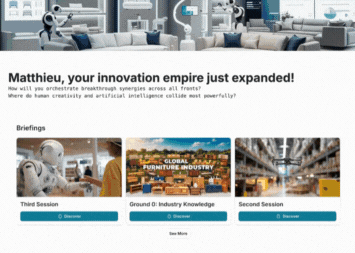Summary:
Navigating stakeholder management in innovation projects often reveals the gap between textbook strategies and real-world complexities. Success hinges not on having the best ideas, but on political acumen. Traditional training falls short, while immersive simulations offer practical experience in managing competing priorities and navigating corporate politics effectively.
We thought we understood stakeholder management until we tried to get the CFO to approve a $20 million budget while the CMO was questioning our mandate and engineering was pushing back on timelines. Sound familiar?
A Quest Series Participant
That moment of recognition hit multiple Strategy Quest participants during our recent simulations. They'd come in confident about their stakeholder management skills—MBA frameworks memorized, mapping templates ready, communication plans polished. Then they faced the reality: three departments with competing priorities, a skeptical C-suite, and resources that suddenly felt more like chess pieces than budget line items.
When debriefing about it, we discovered it isn't unique to our simulation. It's playing out in conference rooms across corporate world every single day.
The uncomfortable truth about innovation failure
Here's what nobody talks about in those polished Harvard Business Review case studies: most innovation projects don't fail because the technology doesn't work or the market doesn't exist. They fail because the innovation leader couldn't navigate the politics.
You know the scenario.
Your team has a breakthrough idea.
The market research looks promising.
The technical feasibility checks out.
You're ready to change the world—or at least your corner of it.
Then you walk into that stakeholder meeting and reality hits like a freight train.
And yup, happened to me just recently... again.
The CFO wants ROI projections for something that's inherently uncertain. Marketing questions whether this falls under their purview or yours. Engineering pushes back because they're already drowning in technical debt. Legal raises compliance concerns. And somehow, in all of this, your brilliant innovation gets lost in a maze of organizational politics that nobody prepared you for.
When textbook theory meets corporate reality
Traditional stakeholder management training treats organizations like rational systems where clear communication and logical arguments win the day:
>> Map your stakeholders, they say.
>> Understand their interests.
>> Communicate the value proposition.
>>Manage the change process.
It's elegant in its simplicity. It's also completely divorced from reality.
Real organizations are complex ecosystems where departments compete for resources, individuals protect their turf, and hidden agendas shape decisions more than formal presentations.
The CFO isn't just evaluating your business case: they're thinking about how this affects their quarterly numbers and their standing with the CEO.
The CMO isn't just questioning scope:they're worried about being marginalized in a customer-experience conversation they think they should own.
And you? You're standing there with your stakeholder map and communication plan, wondering why nobody seems to care about the compelling logic of your innovation proposal.

The political skills nobody taught you
Here's the thing: political navigation isn't about being manipulative or playing games.
It's about understanding that innovation happens in human systems, and human systems are inherently political. Every organization has informal power structures, unspoken rules, and cultural dynamics that determine what gets approved and what gets killed.
The innovation leaders who succeed aren't necessarily the ones with the best ideas, they're the ones who understand how to work within these systems.
They know when to push and when to pull back.
They understand who the real decision-makers are (hint: it's not always the person with the title).
They can read a room and sense when sentiment is shifting.
Most importantly, they understand that successful innovation requires building coalitions. You can't strong-arm your way to innovation success. You need allies, champions, and people who will advocate for your projects when you're not in the room.
The CFO isn't the enemy
Let's talk about that CFO situation specifically, since it's one of the most common pain points our participants face: The natural reaction is to see finance as the enemy of innovation (a.k.a. the bean counters who don't understand vision, who kill creativity with spreadsheets.
This adversarial framing guarantees failure.
Smart innovation leaders realize that CFOs aren't trying to kill innovation: they're trying to manage risk and deliver predictable results to shareholders who expect consistent performance. They're operating in a system that rewards quarterly predictability, not breakthrough uncertainty.
Once you understand this, you can work with it instead of against it:
- Frame innovation as portfolio management across different risk profiles.
- Show how innovation fits into the overall growth strategy.
- Demonstrate that you understand the financial realities of the business, not just the technical possibilities of your project.
The CFO becomes an ally when they see that you're not just another wide-eyed innovator asking for blank checks, you're a strategic partner who understands the business context of innovation.

What political sophistication actually looks like
Watch the innovation leaders who consistently get their projects funded, resourced, and supported. They do things differently.
They spend time understanding the informal organization chart: who influences whom, where the real power lies, what motivates different stakeholders. They invest in relationships before they need them. They frame their innovations in terms that resonate with different audiences: efficiency gains for operations, competitive advantages for strategy, customer satisfaction for marketing.
They also understand timing. They know when the organization is ready for certain conversations and when to wait. They can sense when a project needs to be repositioned, paused, or pivoted based on changing organizational dynamics.
Most importantly, they understand that innovation is as much about influence as it is about invention. They're comfortable operating in the gray areas where formal processes don't provide clear guidance, where success depends on reading situations and adapting accordingly.
The limits of traditional training
Traditional stakeholder management training fails because it treats politics as a problem to be solved rather than a reality to be navigated. It assumes that rational communication in a structured process will overcome organizational complexity. It prepares you for the organization chart, not the organization culture.
You can't learn political navigation from case studies about other companies in other industries facing other challenges. You can't develop influence skills by analyzing stakeholder matrices. You can't build coalition-building capabilities through role-playing exercises that last thirty minutes.
Real political skill develops through experience. Specifically, experience that includes the emotional weight, time pressure, and genuine consequences that characterize actual organizational life. You need to feel what it's like when your carefully crafted proposal gets shot down for reasons nobody wants to articulate. You need to experience the frustration of watching a inferior idea get approved because its champion had better political instincts.

The simulation advantage
This is why immersive simulations work where traditional training doesn't.
In our Strategy Quest sessions, participants don't just discuss stakeholder management—they live it. They experience what it feels like when the engineering team pushes back on their timeline while the CEO is breathing down their neck for results. They learn to read the subtle cues that indicate when someone is really on board versus just being polite.
They practice having difficult conversations under pressure. They learn to pivot their messaging when they realize their initial approach isn't landing. They experience the satisfaction of building genuine consensus around a challenging decision.
Most importantly, they develop the confidence that comes from having navigated complex stakeholder dynamics successfully, even if it was "just" a simulation. That confidence translates directly to real-world effectiveness.
Beyond the stakeholder map
So what does this mean for you as an innovation leader? It means expanding your definition of innovation competence to include political navigation. It means recognizing that understanding organizational dynamics is as important as understanding market dynamics. It means accepting that influence and persuasion are core innovation skills, not nice-to-have soft skills.
It also means being honest about the limits of what you can learn from books, articles, and traditional training programs. Real political skill requires real practice in realistic environments with genuine consequences and emotional stakes.
The question isn't whether your organization has politics (short answer: all organizations do). The question is whether you'll develop the skills to navigate those politics effectively, or continue to wonder why your great innovations keep getting derailed by forces you don't fully understand.
Because here's the brutal truth: in the innovation game, the best idea doesn't always win. The best-executed idea wins. And execution, especially in large organizations, is fundamentally a political challenge.
Ready to experience stakeholder dynamics that actually challenge you? Strategy Quest simulations put you in the hot seat with competing agendas, resource battles, and the kind of political complexity that textbooks can't capture. Because when your next $20 million budget conversation arrives, you'll want more than theory on your side.


